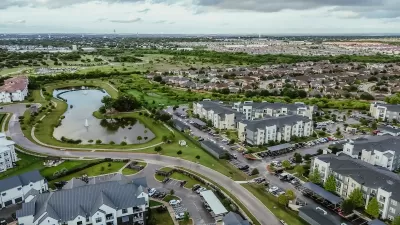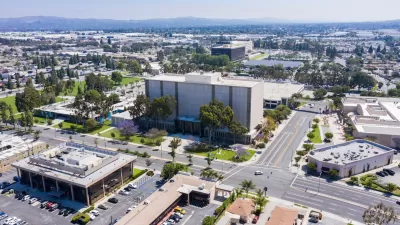The state legislature passed dozens of new laws aimed at improving housing affordability and streamlining the development process to meet rising demand.

With some of the costliest housing markets in the country, California desperately needs solutions that advance both short- and long-term affordable housing goals and reduce the risk of falling into homelessness facing many of the state’s households. A set of new California laws could help stem the state’s housing crisis and steer development toward higher density, more transit-oriented and mixed-used neighborhoods. We take a look at some of the key laws passed — or vetoed — by Governor Gavin Newsom in recent weeks.
One of the more impactful new laws could be Assembly Bill 1893, which restricts the so-called ‘Builder’s Remedy’ from its current ‘free-for-all’ incarnation, setting new site restrictions, density limits, and other standards for new developments. However, it also reduces affordability requirements and offers explicit protection from some mechanisms used to block development. The Builder’s Remedy, an obscure provision in state law, gained attention in recent years as developers began eyeing it as a loophole that exempts them from local zoning regulations in cities without a state-approved housing element. This essentially let builders begin work on projects without waiting for city approvals and without adhering to existing rules such as lot size limits, setbacks, and height limits. The provision is intended as a deterrent to cities that defy the state mandate to submit plans for supporting enough housing development to meet demand. Until now, the language around the Builder’s Remedy was vague and the provision was largely overlooked and rarely used. AB 1893 clarifies the law, keeping it in place but reining in the rights of developers.
AB 2243 streamlines approvals for housing developments in more areas, such as malls and land near highways. The bill expands a 2022 law to include regional mall sites of up to 100 acres and allows a streamlined approval process for developments within 500 feet of a freeway, provided that the projects meet requirements including centralized ventilation systems. In addition, the bill bars local governments from imposing density limits on adaptive reuse projects that create new residential units.
AB 3093 requires that local housing elements include housing for households making up to 15 percent and up to 30 percent of area median income (AMI) to ensure housing availability for the lowest-income families and people most at risk of falling into homelessness. According to the Los Angeles Times, “Currently, the lowest income bracket that communities must plan for is less than 50% of area median income, meaning in theory that cities could fulfill those goals by building housing just for people making 49% of local income.”
Senate Bill 1037 raises penalties for jurisdictions that violate state housing regulations, strengthening the state’s power to enforce the Regional Housing Needs Allocation mandates for housing elements that support affordable housing production. Under the new law, cities can be fined up to $50,000 per month for continuing violations, funds that will be directed to income-restricted housing in those communities.
AB 2347 doubles the time for tenants to respond to eviction notices from 5 to 10 business days. The bill is intended to give tenants more time to access legal assistance and other resources. In California, research indicates that roughly 40 percent of tenants lose their eviction cases by default simply because they don’t have the time to respond. However, the law also shortens the time attorneys have to file certain motions on behalf of tenants.
AB 2580 limits cities’ ability to use historic designations as a tool to stifle housing development by requiring them to submit reports on how new historic designations will impact the local housing supply. The bill is supported by housing advocates who say that some jurisdictions have abused historic preservation ordinances to kill housing projects and skirt state requirements. Historic preservation is just one of the tools California cities have employed to push back on housing requirements.
The governor vetoed other housing-related bills, including AB 3068, which would have mandated by-right approval for office-to-residential and mixed-use conversions in central cities. The governor cited concerns about the law’s expanded labor standard enforcement mechanisms and procedures for contesting violations. Newsom also vetoed AB 2903, which would have increased the state’s accountability in its spending of funds meant to reduce homelessness, arguing that the bill was redundant and that it is cities and counties, rather than state programs, that need stricter regulations around their spending.
This session, the legislature passed 32 laws related to housing and land use that, together, could reduce pressure on the state’s housing supply and promote more sustainable and affordable development.

Planetizen Federal Action Tracker
A weekly monitor of how Trump’s orders and actions are impacting planners and planning in America.

DARTSpace Platform Streamlines Dallas TOD Application Process
The Dallas transit agency hopes a shorter permitting timeline will boost transit-oriented development around rail stations.

Congressman Proposes Bill to Rename DC Metro “Trump Train”
The Make Autorail Great Again Act would withhold federal funding to the system until the Washington Metropolitan Area Transit Authority (WMATA), rebrands as the Washington Metropolitan Authority for Greater Access (WMAGA).

Supreme Court Ruling in Pipeline Case Guts Federal Environmental Law
The decision limits the scope of a federal law that mandates extensive environmental impact reviews of energy, infrastructure, and transportation projects.

Texas State Bills to Defund Dallas Transit Die
DART would have seen a 30% service cut, $230M annual losses had the bills survived.

Bikeshare for the Win: Team Pedals to London Cricket Match, Beats Rivals Stuck in Traffic
While their opponents sat in gridlock, England's national cricket team hopped Lime bikes, riding to a 3-0 victory.
Urban Design for Planners 1: Software Tools
This six-course series explores essential urban design concepts using open source software and equips planners with the tools they need to participate fully in the urban design process.
Planning for Universal Design
Learn the tools for implementing Universal Design in planning regulations.
Roanoke Valley-Alleghany Regional Commission
City of Mt Shasta
City of Camden Redevelopment Agency
City of Astoria
Transportation Research & Education Center (TREC) at Portland State University
US High Speed Rail Association
City of Camden Redevelopment Agency
Municipality of Princeton (NJ)






























